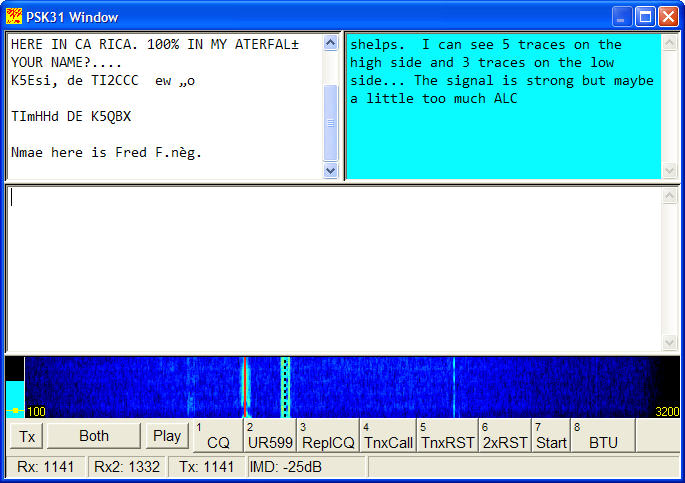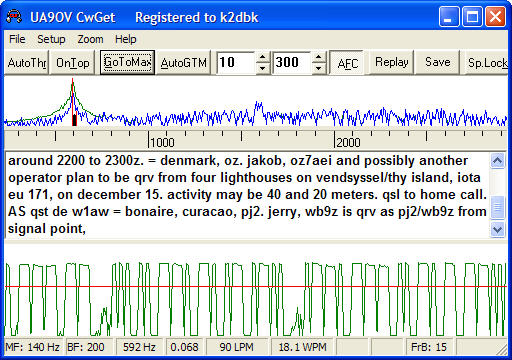The Digital Mode Tools
One of the really nice things about having a computer in the shack is that many of the digital modes that used to require dedicated hardware (like RTTY) can now be easily done with just a sound card and a simple interface. This makes it really easy to try out new modes without spending a fortune on dedicated hardware. It also makes it possible for programmers to create and modify new modes quickly and easily without worrying about obsoleting the old hardware.
The two digital modes that I use most often are PSK31 and RTTY. I don't do all that much of either, but now and then I'll get my feet wet by playing in a RTTY contest or working someone on PSK maybe as a new country or mode or band. There are really just a couple of programs that I use for
 these digital outings. Most of the time, if I'm working PSK, I simply use the built-in PSK window in DX4WIN. It doesn't have as many features as some of the more advanced stand-alone PSK programs (check out the PSK31 link above for some of the programs available as well as the list at AC6Vs web pages) and it doesn't yet support the newer PSK63 mode. (Although in doing a little research for this posting, the PSK63 link does explain how to retrofit the PSK63 engine into programs that don't natively support PSK63, I'll have to give it a shot with DX4WIN). However, the advantage is that it's integrated into DX4WIN, so clicking on a callsign will automatically put the callsign into the callsign field of the logger, etc. For me, this is fine for casual contacts, or even trying to work a DXPedition, though I don't think I'd really want to use it for a contest.
these digital outings. Most of the time, if I'm working PSK, I simply use the built-in PSK window in DX4WIN. It doesn't have as many features as some of the more advanced stand-alone PSK programs (check out the PSK31 link above for some of the programs available as well as the list at AC6Vs web pages) and it doesn't yet support the newer PSK63 mode. (Although in doing a little research for this posting, the PSK63 link does explain how to retrofit the PSK63 engine into programs that don't natively support PSK63, I'll have to give it a shot with DX4WIN). However, the advantage is that it's integrated into DX4WIN, so clicking on a callsign will automatically put the callsign into the callsign field of the logger, etc. For me, this is fine for casual contacts, or even trying to work a DXPedition, though I don't think I'd really want to use it for a contest.For those of you who might not have seen PSK31 in action, the screenshot here from DX4WIN shows that I've got two different QSOs that I'm decoding "listening to" at the same time, with the window on the left being the primary frequency (meaning that if I were to transmit, it would transmit there) and the window on the right showing a secondary frequency QSO. Note again that this is all done in software, the radio is actually in SSB mode and all the magic happens on the computer. Some of the more advanced programs are capable of decoding many more conversations at once.
For RTTY use, MMTTY is the way to go. MMTTY is definitely the cream of the crop here, and has all the bells and whistles you could ever want. The author of MMTTY, Mako (JE3HHT) has
 allowed programmers to integrate MMTTY into their programs, so it's very well supported by most logging programs (both DX4WIN and the N1MM loggers that I user support it), but it can also be used as a standalone program. In fact, the standalone program has support built in for at least a few popular contests, and I have on occasion done a RTTY contest entirely with MMTTY (though usually at the end I export the logs and import them into N1MM for score computation and DX4WIN to track everything else). There's a lot to learn about this powerful program, and aside from the information on the authors website, I highly recommend the AA5AU RTTY page, which walks you though how to use MMTTY as well as giving a general explanation about what RTTY is.
allowed programmers to integrate MMTTY into their programs, so it's very well supported by most logging programs (both DX4WIN and the N1MM loggers that I user support it), but it can also be used as a standalone program. In fact, the standalone program has support built in for at least a few popular contests, and I have on occasion done a RTTY contest entirely with MMTTY (though usually at the end I export the logs and import them into N1MM for score computation and DX4WIN to track everything else). There's a lot to learn about this powerful program, and aside from the information on the authors website, I highly recommend the AA5AU RTTY page, which walks you though how to use MMTTY as well as giving a general explanation about what RTTY is.Of course, there is another very well-known mode that I think can be called digital: CW. Both of my two main logging programs support sending CW directly from the program, either with macros or via the keyboard. N1MM has a very high degree of integration in that it's easy to configure macros to use during a contest that will take the callsign that you've just entered and put it into a macro along with the contest exchange, including things like a changing serial number.
However, I do use one standalone tool (which can run along with my loggers) to help me copy CW. Although I know that my CW copying skills have improved, they have quite a long way to go before I'll be able to comfortably and confidently copy even a formatted contest exchange at high (30+ wpm) speeds. Although I can copy, by ear, certain elements of an exchange (like my callsign,
 typical RST reports, key phrases like "UP" or "AGN?"), for contest use and (less often) for working DX contacts I will use a
typical RST reports, key phrases like "UP" or "AGN?"), for contest use and (less often) for working DX contacts I will use a To explain what's shown in the screen shot, there are 3 window on the screen: The top window shows where in the bandpass CwGet is "listening" (in this case, it's at 592Hz, which is the audio tone my receiving is generating for the CW being received), the second window shows the decoded text, and the bottom window shows the dihs and dahs coming in. The red horizontal line is essentially a "squelch", meaning that anything below that line will be ignored. In the particular screenshot here, CwGet is copying the weekly DX Bulletin from the ARRL. (This was from their 40m broadcast, and given that I've relatively close to ARRL HQ, it's a very strong signal, so the decoding is perfect; this isn't always the case.)
Incidentally, both CwGet and the PSK31 decoder have some other interesting uses: A while ago, there was an odd hum on the output of one of the local 2m FM repeaters. I fed the audio into CwGet and I was able to figure out that what I was hearing was the CTCSS (PL) tone for that repeater, which was just a bit louder than it should have been.
I've got one more part in this series, where I'll talk about a few miscellaneous tools that didn't fit into any of the previous categories.
No comments:
Post a Comment